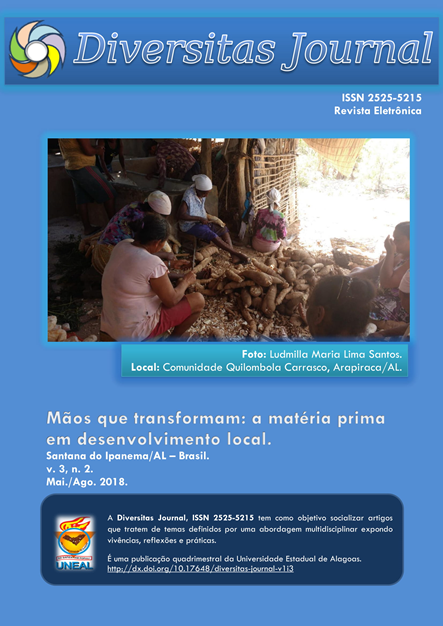Atividade antibacteriana e antiaderente do extrato de Mimosa caesalpiniaefolia Benth sobre micro-organismos do biofilme dentário
DOI:
https://doi.org/10.17648/diversitas-journal-v3i2.639Abstract
RESUMO: A cárie dentária e doenças periodontais são as duas ameaças comuns à saúde bucal e importantes problemas de saúde pública por causa de seu impacto sobre os indivíduos. O S. mutans é considerado o principal agente etiológico da cárie dentária em humanos. Erradicação de biofilmes microbianos é uma tarefa difícil. Frente às limitações dos métodos mecânicos de higiene. Esse trabalho teve como objetivo avaliar a atividade antibacteriana e antiaderente do extrato de Mimosa caesalpiniaefolia Benth sobre micro-organismos do biofilme dentário. Trata-se de um estudo analítico experimental in vitro. O teste de triagem e a CIM foram analisados pelo método de microdiluição em caldo. As linhagens cariogênicas e formadoras de biofilme dental analisadas foram Streptococcus mitis ATCC 9811, Streptococcus mutans ATCC 25175, Streptococcus sanguis ATCC 10557, Streptococcus sobrinus ATCC 27609 e Lactobacillus casei ATCC 7469. Foi visto que na durante a atividade antibacteriana do extrato das folhas de Mimosa caesalpinifolia sobre linhagens cariogênicas e formadas de biofilme dental que a espécie estudada apresentou Concentração inibitória mínima e Concentração bactericida mínima sobre Streptococcus mutans ATCC 25175 e Streptococcus mitis ATCC 9811. O extrato etanólico das folhas de Mimosa caesalpinifolia apresentou ação antimicrobiana significativa e atividade inibitória mínima da aderência in vitro sobre as linhagens de Streptococcus mitis e Streptococcus mutans, presentes no biofilme bacteriano.
PALAVRAS-CHAVE: Biofilme Dentário, Placa Bacteriana, Extratos Naturais.
ABSTRACT: Dental caries and periodontal diseases are the two common threats to oral health and important public health problems because of your impact on individuals. S. mutans is considered the main Etiologic Agent of dental caries in humans. Eradication of biofilm is a difficult task. Facing the limitations of mechanical methods of hygiene. This work aimed to evaluate the antibacterial activity and Mimosa caesalpiniaefolia extract nonstick Benth on dental biofilm microorganisms. It is an analytical study in vitro trial. The screening test and the CIM were analyzed by the method of microdiluição in broth. The lines cariogênicas and dental biofilm-forming analyzed were Streptococcus mitis ATCC ATCC 25175 9811, Streptococcus mutans, Streptococcus sanguis ATCC 10557, Streptococcus sobrinus 27609 and Lactobacillus casei ATCC ATCC 7469. It has been seen that in during the antibacterial activity of the extract of the leaves of Mimosa caesalpinifolia on cariogênicas lines and formed of dental biofilm that the species studied showed minimum inhibitory concentration and minimum bactericidal Concentration about Streptococcus mutans ATCC 25175 and Streptococcus mitis ATCC 9811. The ethanolic extract of leaves of Mimosa caesalpinifolia presented significant antimicrobial action and minimum inhibitory activity in vitro on the adherence of Streptococcus mitis strains and Streptococcus mutans, present in the bacterial biofilm.
PALAVRAS-CHAVE: Biofilme Dentário, Placa Bacteriana, Extratos Naturais.
Metrics
References
JOSE, M. et al. Ethnomedicinal Herbs Used in Oral Health and Hygiene in Coastal Dakshina Kannada. J Oral Health Comm Dent, p. 119–123, 2011.
ABREU-PINHEIRO, M. et al. Efeito antimicrobiano de tinturas de produtos naturais sobre bactérias da cárie dentária. RBPS, v. 25, n. 2, p. 1-5, 2012
BARNABÉ, M. et al. The influence of Brazilian Plant Extracts on Streptococcus mutans biofilm. Journal os applied oral science, p. 366-72, 2014.
OLIVEIRA, G. P. et al. Antimicrobial activity in vitro of the oral cavity. Revista Fitos, v. 8, n. 2, p. 95-102, 2013.
MACÊDO-COSTA, M. R. et al. Atividade antimicrobiana e antiaderente do extrato de mimosa tenuiflora (Willd). Poir. sobre microrganismos do biofilme dentário. Pesquisa Brasileira em Odontopediatria e clinica integrada, v. 9, n. 2, p. 161-165, 2009.
LUCENA-VIEIRA, E. et al. Composição química de forrageiras e seletividade de bovinos em bosque-de-sabiá (Mimosa caesalpiniifolia Benth) nos períodos chuvosos e seco. Revista Brasileira de Zootecnia, v. 34, n. 5, p. 1505-1511, 2005.
TRENTIN, D. D. S. et al. Potential of medicinal plants from the Brazilian semi-arid region (Caatinga) against Staphylococcus epidemidis planktonic and biofilm lifestyles. Journal of Ethnopharmacology, p. 327-335, 2011.
ALVES, P. M.; QUEIROZ, L. M. G.; PEREIRA, J. V.; PEREIRA, M.S.V. Atividade antimicrobiana, antiaderente e antifúngica in vitro de plantas medicinais brasileiras sobre microrganismos do biofilme dental e cepas do gênero Candida. Revista da Sociedade Brasileira de Medicina Tropical, v.42, n.2, p.222-224, 2009.
SILVA, M. M.; VERGANI, C. E.; GIAMPAOLO, E. T.; NEPPELENBROEK, K. H.; SPOLIDORIO, D. M.; MACHADO, A. L. Effectiveness of microwave irradiation on the disinfection of complete dentures. International Journal of Prosthodontics, v. 19, n. 3, p. 288-93, 2006.
PEREIRA, C. V. Ação das amostras de Streptococcus mutans e Streptococcus sobrinus sobre diferentes carbohidratos com ênfase dentária – estudo in vitro. Revista Passo Fundo, v. 4, p.33-39, 1999.
VASCONCELOS, L. C. de - Avaliação da higiene oral em usuários de prótese dentária: importância no controle da estomatite protética. Trabalho de Conclusão de Curso apresentado ao Curso de Graduação em Odontologia da Universidade Federal da Paraíba em cumprimento às exigências para conclusão. 2010. 74 páginas.
Downloads
Published
How to Cite
Issue
Section
License
Copyright (c) 2019 Felipe Henrique de Souza Lima, Gustavo Shilmaney Damasceno, Luana Luzia Santos Pires, João Gomes da Costa, Thiago José Matos Rocha, Aldenir Feitosa dos Santos

This work is licensed under a Creative Commons Attribution 4.0 International License.
The Diversitas Journal expresses that the articles are the sole responsibility of the Authors, who are familiar with Brazilian and international legislation.
Articles are peer-reviewed and care should be taken to warn of the possible incidence of plagiarism. However, plagiarism is an indisputable action by the authors.
The violation of copyright is a crime, provided for in article 184 of the Brazilian Penal Code: “Art. 184 Violating copyright and related rights: Penalty - detention, from 3 (three) months to 1 (one) year, or fine. § 1 If the violation consists of total or partial reproduction, for the purpose of direct or indirect profit, by any means or process, of intellectual work, interpretation, performance or phonogram, without the express authorization of the author, the performer, the producer , as the case may be, or whoever represents them: Penalty - imprisonment, from 2 (two) to 4 (four) years, and a fine. ”


















